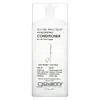What's inside
What's inside
 Key Ingredients
Key Ingredients

 Benefits
Benefits

 Concerns
Concerns

 Ingredients Side-by-side
Ingredients Side-by-side

Water
Skin ConditioningCetyl Alcohol
EmollientStearyl Alcohol
EmollientMelaleuca Alternifolia Leaf Oil
AntioxidantMentha Piperita Oil
MaskingRosmarinus Officinalis Leaf Extract
AntimicrobialMenthol
MaskingEucalyptus Globulus Leaf Oil
PerfumingAloe Barbadensis Leaf Juice
Skin ConditioningLavandula Angustifolia Flower/Leaf/Stem Extract
MaskingPropanediol
SolventSalvia Officinalis Leaf Extract
CleansingChamomilla Recutita Flower Extract
MaskingThymus Vulgaris Extract
PerfumingParfum
MaskingPhenoxyethanol
PreservativePanthenol
Skin ConditioningCetrimonium Bromide
AntimicrobialEthylhexylglycerin
Skin ConditioningWater, Cetyl Alcohol, Stearyl Alcohol, Melaleuca Alternifolia Leaf Oil, Mentha Piperita Oil, Rosmarinus Officinalis Leaf Extract, Menthol, Eucalyptus Globulus Leaf Oil, Aloe Barbadensis Leaf Juice, Lavandula Angustifolia Flower/Leaf/Stem Extract, Propanediol, Salvia Officinalis Leaf Extract, Chamomilla Recutita Flower Extract, Thymus Vulgaris Extract, Parfum, Phenoxyethanol, Panthenol, Cetrimonium Bromide, Ethylhexylglycerin
Glycerin
HumectantStearyl Alcohol
EmollientDimethicone
EmollientBehenyl Alcohol
EmollientCetearyl Alcohol
EmollientMenthol
MaskingHydroxyethyl Urea
HumectantAminopropyl Dimethicone
Steartrimonium Chloride
PreservativeHydrogenated Polyisobutene
EmollientLactic Acid
BufferingPolysilicone-13
Phytosteryl/Octyldodecyl Lauroyl Glutamate
Skin ConditioningCamellia Seed Oil
Sodium Lauroyl Glutamate
Bis-Ethylhexyloxyphenol Methoxyphenyl Triazine
Skin ConditioningRoyal Jelly Extract
Skin ConditioningGlycine Max Seed Extract
Skin ConditioningIsopropyl Alcohol
SolventDipropylene Glycol
HumectantIsopropyl Myristate
EmollientPEG-2 Laurate
EmulsifyingAmodimethicone
Salicylic Acid
MaskingPPG-2-Deceth-12
EmulsifyingDisodium EDTA
Ammonium Lactate
BufferingCetrimonium Chloride
AntimicrobialEthylhexyl Palmitate
EmollientButylene Glycol
HumectantTocopherol
AntioxidantSodium Benzoate
MaskingPhenoxyethanol
PreservativeParfum
MaskingGlycerin, Stearyl Alcohol, Dimethicone, Behenyl Alcohol, Cetearyl Alcohol, Menthol, Hydroxyethyl Urea, Aminopropyl Dimethicone, Steartrimonium Chloride, Hydrogenated Polyisobutene, Lactic Acid, Polysilicone-13, Phytosteryl/Octyldodecyl Lauroyl Glutamate, Camellia Seed Oil, Sodium Lauroyl Glutamate, Bis-Ethylhexyloxyphenol Methoxyphenyl Triazine, Royal Jelly Extract, Glycine Max Seed Extract, Isopropyl Alcohol, Dipropylene Glycol, Isopropyl Myristate, PEG-2 Laurate, Amodimethicone, Salicylic Acid, PPG-2-Deceth-12, Disodium EDTA, Ammonium Lactate, Cetrimonium Chloride, Ethylhexyl Palmitate, Butylene Glycol, Tocopherol, Sodium Benzoate, Phenoxyethanol, Parfum
 Reviews
Reviews

Ingredients Explained
These ingredients are found in both products.
Ingredients higher up in an ingredient list are typically present in a larger amount.
Menthol is a compound found in mint plants, such as peppermint. In its pure form, it is a clear crystalline substance.
Menthol is known for its cooling sensation; however, the cooling is actually from your skin being sensitized. Menthol can worsen rosacea. We recommend speaking with a professional if you have concerns.
Menthol also has antimicrobial properties.
Learn more about MentholParfum is a catch-all term for an ingredient or more that is used to give a scent to products.
Also called "fragrance", this ingredient can be a blend of hundreds of chemicals or plant oils. This means every product with "fragrance" or "parfum" in the ingredients list is a different mixture.
For instance, Habanolide is a proprietary trade name for a specific aroma chemical. When used as a fragrance ingredient in cosmetics, most aroma chemicals fall under the broad labeling category of “FRAGRANCE” or “PARFUM” according to EU and US regulations.
The term 'parfum' or 'fragrance' is not regulated in many countries. In many cases, it is up to the brand to define this term.
For instance, many brands choose to label themselves as "fragrance-free" because they are not using synthetic fragrances. However, their products may still contain ingredients such as essential oils that are considered a fragrance by INCI standards.
One example is Calendula flower extract. Calendula is an essential oil that still imparts a scent or 'fragrance'.
Depending on the blend, the ingredients in the mixture can cause allergies and sensitivities on the skin. Some ingredients that are known EU allergens include linalool and citronellol.
Parfum can also be used to mask or cover an unpleasant scent.
The bottom line is: not all fragrances/parfum/ingredients are created equally. If you are worried about fragrances, we recommend taking a closer look at an ingredient. And of course, we always recommend speaking with a professional.
Learn more about ParfumPhenoxyethanol is a preservative that has germicide, antimicrobial, and aromatic properties. Studies show that phenoxyethanol can prevent microbial growth. By itself, it has a scent that is similar to that of a rose.
It's often used in formulations along with Caprylyl Glycol to preserve the shelf life of products.
Stearyl Alcohol is a type of fatty alcohol from stearic acid. It is a white, waxy compound used to emulsify ingredients.
Fatty Alcohols are most often used as an emollient or to thicken a product. Emollients help soothe and hydrate the skin by trapping moisture.
They are usually derived from natural fats and oils and therefore do not have the same drying or irritating effect as solvent alcohols. FDA allows products labeled "alcohol-free" to have fatty alcohols.
Learn more about Stearyl Alcohol